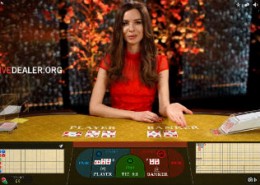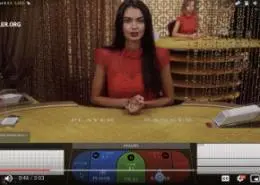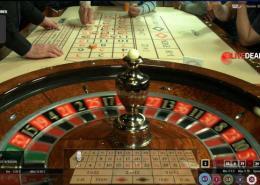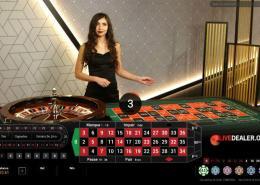An introduction to live online casino gambling (Part 2)
About live blackjack
As one of the most popular casino games, blackjack is offered by most live dealer platforms, and certainly all listed on this site.
House rules:
All casinos include their blackjack house rules either on their websites or somewhere in the game interface but they can be difficult to find at times.
For your convenience we’ve include, where relevant, pages outlining the house rules at each casino. At the risk of generalizing, most live blackjack games employ ‘standard’ blackjack rules, dealt from an 8 or 6 deck shoe (8 is more common). A summary of key variation components and associated house edges may be found at our live blackjack house rules page. Additionally, if you wish to know the house edge applying to each game (assuming optimal play), these are set out at our blackjack house edge page.
Casino shuffle policy:
A very important consideration with regard to players’ ability to count is the live casino’s shuffle policy, or where the dealer is instructed to place the cut card. A more detailed discussion of shuffle policy is included at the above link, and as you may expect, all live casinos employ adequate counter-measures to prevent players being able to effectively count cards playing live blackjack. Typically shuffles occur mid-shoe (ie approximately 4 decks into the 8 deck shoe) or at regular intervals.
Single versus multi-player-deal format:
Most live blackjack games are offered in multiplayer (7 seat) format. When you join a table you will be allocated a seat at a 7 seat table along with any other players currently playing – as you would at a terrestrial casino. The dealer is made aware that a new player has joined the table and should you place a bet in your bet box you will be dealt a hand. Each player plays his/her hand in turn as is the convention at a bricks and mortar casino, and a fixed time limit is afforded to both place your bet, and to make your hit/stand/double/split bet decision.
As you can imagine, a full 7 seat table can make for a slow game where players take the full time allotted to play their hands.
Less common, is the format where the dealer deals a single blackjack hand, albeit to many players sitting on the other end of the video stream (sometimes referred to as ‘one-to-many’ live games). This makes for a much faster game, but also requires slight differences to blackjack deal convention to accommodate the many players participating in the deal.
You might notice playing these games that while you have chosen to stand, additional cards are dealt by the dealer to the ‘player’ hand. These are the additional cards requested by other players and will not be attributed to your hand. This can be confusing at first but the important thing to remember is that regardless of the deal convention, (broadly speaking) standard blackjack rules apply and your hand will always be represented by the ‘virtual’ cards depicted on the interface graphic in addition to the actual cards that are dealt.
Oversize cards and virtual replication:
The cards dealt in live blackjack are generally oversized for easy viewing via the video stream. In addition to the actual cards being dealt, a virtual graphic is provided on the playing interface showing depicting the deal. The dealer swipes the actual cards over a scanner on the table which reads the card and presents it on the interface graphic accordingly.
Video demos:
Comparisons of the various blackjack platforms and detailed interface reviews may be found at our live dealer blackjack page.
About live baccarat
From a logistical point of view, baccarat is a simpler game to offer in live dealer format simply because no bet decisions are required during the deal. Players bet on ‘player’, ‘banker’ or ‘tie’ and let the dealer do the rest. Aside from a few baccarat variations, ‘standard’ baccarat rules are typically offered with the game dealt from an 8 deck shoe.
We have included for convenience at game review pages, copies of the casinos’ baccarat house rules.
Oversize cards and virtual replication:
As for live blackjack, baccarat games are dealt using oversize cards that may be clearly seen via the interface video stream. The actual cards dealt are also depicted on a virtual graphic on the bet interface so you can clearly view your hand. The dealer swipes the actual cards over a scanner on the table which reads the card and presents it on the interface graphic accordingly.
Video demos:
Comparisons of the various baccarat platforms and detailed interface reviews may be found at our live dealer baccarat page.
About live roulette
Typically offered in single zero (European format) live roulette is offered by most live casinos (platform providers) and certainly all listed on this site. Copies of roulette house rules and applicable payouts for roulette games reviewed on this site have been provided where relevant.
Playing live roulette you will be given a fixed time limit to place your bet(s). Once bets are placed and ball is dropped, typically the video will zoom onto the wheel to show the spin outcome.
Video demos:
Comparisons of the various roulette platforms and detailed interface reviews may be found at our live croupier roulette page.
Playing for free
While most online casinos are happy for players to play in free-play mode to their hearts content on their RNG (random number generator) games, this is not typically the case with live games. I guess the logic applying here is that there is no marginal cost of serving additional RNG games, while live games require additional salaried dealers to service additional players – a cost that casinos want recouped from real money play.
Some live casinos do offer free play which is a really nice feature that enables you to both get a feel for the live game format, as well as better understand the features and any peculiarities of the interface.
Those that don’t offer free play, still allow players to load and view the games in ‘real play’ mode without having to actually place a bet.
A complete list of casinos offering free play is set out at our free live casino games page.
Banking, deposits and withdrawals
In order to play for real money, you will need to deposit funds into your casino playing account. Casinos, like most online merchants offer a range of deposit options including credit cards and numerous virtual wallet or ‘e-wallet’ services like PayPal and NeTeller.
Some players, particularly those from the US, may find depositing via VISA, Mastercard, Diners Club or American Express problematic due to UIGEA restrictions. The Unlawful Internet Gambling Enforcement Act came into effect in 2006 and imposes obligations on US banks and payment processing companies to block online gambling related transactions made by US residents.
Deposit instructions are generally clearly set out at most live casinos, as are instructions for withdrawal requests.
Some cool game features
Live casino games are clearly developed with the goal of providing a gaming experience that is as close as possible to traditional ‘bricks and mortar’ casino gambling. Platform providers have added a number of nifty features to their interfaces to this end. Set out below are some of the better features we have encountered.
Chat:
Quite a few platforms offer the ability to chat to the dealer and other players. Of course you shouldn’t expect replies from the dealer mid deal – they are otherwise engaged at this point. Nor should you expect a deep and meaningful exchange between deals/spins. Responses from dealers are generally polite but brief. Comments from other players on the other hand can be a mixed bag.
Video view customization:
Most platforms allow you to enlarge the video stream to ‘full screen’ size or play with the video as a smaller widow inset into the game interface. A number offer various view customization options, such as Evolution Gaming’s ‘Classic’ or ‘3D’ game views.
In casino tables:
One of the big developments in live gaming over the last coupe of years has been the proliferation of in-casino tables; that is real casino tables on the floor of well known bricks and mortar casinos that you can play live online. The cool part, is watching patrons inside the casino scrambling to place their bets on the table with physical chips, while you do so online with virtual chips.
Play multiple tables simultaneously:
A number of platforms, notably Playtech and Evolution Gaming, allow you to play multiple live table simultaneously.













